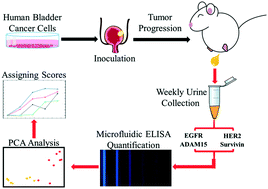Our official English website, www.x-mol.net, welcomes your feedback! (Note: you will need to create a separate account there.)
Multiparameter urine analysis for quantitative bladder cancer surveillance of orthotopic xenografted mice.
Lab on a Chip ( IF 6.1 ) Pub Date : 2020-01-10 , DOI: 10.1039/c9lc01006h Xiaotian Tan 1 , Luke J Broses 2 , Menglian Zhou 1 , Kathleen C Day 2 , Wenyi Liu 1 , Ziqi Li 1 , Alon Z Weizer 2 , Katherine A Munson 2 , Maung Kyaw Khaing Oo 3 , Mark L Day 2 , Xudong Fan 1
Lab on a Chip ( IF 6.1 ) Pub Date : 2020-01-10 , DOI: 10.1039/c9lc01006h Xiaotian Tan 1 , Luke J Broses 2 , Menglian Zhou 1 , Kathleen C Day 2 , Wenyi Liu 1 , Ziqi Li 1 , Alon Z Weizer 2 , Katherine A Munson 2 , Maung Kyaw Khaing Oo 3 , Mark L Day 2 , Xudong Fan 1
Affiliation

|
The human-derived orthotopic xenograft mouse model is an effective platform for performing in vivo bladder cancer studies to examine tumor development, metastasis, and therapeutic effects of drugs. To date, the surveillance of tumor progression in real time for orthotopic bladder xenografts is highly dependent on semi-quantitative in vivo imaging technologies such as bioluminescence. While these imaging technologies can estimate tumor progression, they are burdened with requirements such as anesthetics, specialized equipment, and genetic modification of the injected cell line. Thus, a convenient and non-invasive technology to quantitatively monitor the growth of bladder cancer in orthotopic xenografts is highly desired. In this work, using a microfluidic chemiluminescent ELISA platform, we have successfully developed a rapid, multiparameter urine-based and non-invasive biomolecular prognostic technology for orthotopic bladder cancer xenografts. This method consists of two steps. First, the concentrations of a panel of four urinary biomarkers are quantified from the urine of mice bearing orthotopic bladder xenografts. Second, machine learning and principal component analysis (PCA) algorithms are applied to analyze the urinary biomarkers, and subsequently, a score is assigned to indicate the tumor growth. With this methodology, we have quantitatively monitored the orthotopic growth of human bladder cancer that was inoculated with low, medium, and high cancer cell numbers. We also employed this method and performed a proof of principle experiment to examine the in vivo therapeutic efficacy of the EGFR inhibitor, dacomitinib.
中文翻译:

多参数尿液分析定量监测原位异种移植小鼠的膀胱癌。
人源原位异种移植小鼠模型是进行体内膀胱癌研究以检查药物的肿瘤发生,转移和治疗效果的有效平台。迄今为止,对原位膀胱异种移植物实时监测肿瘤进展高度依赖于半定量体内成像技术,例如生物发光。尽管这些成像技术可以估计肿瘤的进展,但它们却面临着诸如麻醉剂,专用设备以及所注射细胞系的基因修饰之类的要求。因此,迫切需要一种方便且非侵入性的技术来定量监测原位异种移植物中膀胱癌的生长。在这项工作中,我们使用微流体化学发光ELISA平台成功开发了一种快速,多参数基于尿液的非侵入性生物分子预后技术用于原位膀胱癌异种移植。此方法包括两个步骤。首先,从带有原位膀胱异种移植物的小鼠的尿液中量化一组四个尿液生物标志物的浓度。其次,将机器学习和主成分分析(PCA)算法应用于分析尿液生物标志物,随后分配一个分数来指示肿瘤的生长。通过这种方法,我们已经定量监测了接种有低,中和高癌细胞数的人膀胱癌的原位生长。我们还采用了这种方法,并进行了原理验证实验,以检查EGFR抑制剂dacomitinib的体内治疗功效。
更新日期:2020-02-13
中文翻译:

多参数尿液分析定量监测原位异种移植小鼠的膀胱癌。
人源原位异种移植小鼠模型是进行体内膀胱癌研究以检查药物的肿瘤发生,转移和治疗效果的有效平台。迄今为止,对原位膀胱异种移植物实时监测肿瘤进展高度依赖于半定量体内成像技术,例如生物发光。尽管这些成像技术可以估计肿瘤的进展,但它们却面临着诸如麻醉剂,专用设备以及所注射细胞系的基因修饰之类的要求。因此,迫切需要一种方便且非侵入性的技术来定量监测原位异种移植物中膀胱癌的生长。在这项工作中,我们使用微流体化学发光ELISA平台成功开发了一种快速,多参数基于尿液的非侵入性生物分子预后技术用于原位膀胱癌异种移植。此方法包括两个步骤。首先,从带有原位膀胱异种移植物的小鼠的尿液中量化一组四个尿液生物标志物的浓度。其次,将机器学习和主成分分析(PCA)算法应用于分析尿液生物标志物,随后分配一个分数来指示肿瘤的生长。通过这种方法,我们已经定量监测了接种有低,中和高癌细胞数的人膀胱癌的原位生长。我们还采用了这种方法,并进行了原理验证实验,以检查EGFR抑制剂dacomitinib的体内治疗功效。



























 京公网安备 11010802027423号
京公网安备 11010802027423号